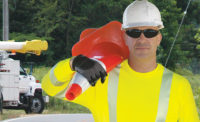FR, AR, CP, FR/CP — the alphabet soup of protective clothing acronyms is overwhelming in and of itself. And when safety depends on choosing the right products, making sense of the acronyms and the various types of workwear they represent is paramount.
A variety of standards and regulations, such as OSHA 1910.132, OSHA 1910.269, NFPA 2113 and NFPA 70E, require workplaces to perform hazard assessments and ensure employees have adequate protection against the identified risks. But with so many types of protective clothing available, how do you know which products are right for your work environment?
The basics
Once you’ve determined the hazards that employees may encounter on the job, you’ll need to identify the workwear that will best protect against those hazards. You may find that you only need one type of protection, or you may need protection against multiple hazards all at once.
If there are multiple hazards present, it is often possible to address them all with a single protective garment. For example, there are products that provide both high visibility and flame-resistant protection. Other products provide all-in-one protection against flash fire, arc flash and small molten metal splatter. Some products even simultaneously protect against thermal hazards and inadvertent chemical splash. However, there are circumstances where you will still need more than one type of workwear to adequately protect employees.
Of course, the first step in selecting the right workwear is to fully understand your options.
Flame resistant (FR)
FR clothing is designed to self-extinguish when exposed to flame, making it ideal for environments where fire is encountered during work processes, as well as anywhere there is the potential for a flash fire to occur. FR products are used in work environments ranging from the fire service and oil and gas industries to laboratories. FR workwear is also used in the manufacturing and food processing industries, and anywhere else combustible dust may be present.
The NFPA 2112 standard sets the minimum performance requirements garments must meet to be considered FR. NFPA 2113 provides additional guidelines on the selection, care, use and maintenance of FR products. Adhering to these standards helps ensure the FR clothing you select will provide the proper level of protection.
Arc rated (AR)
AR products are designed specifically to protect against electric arc flash hazards. AR products are used by employees working near energized electrical equipment, making them particularly common in the utilities industry.
All AR clothing is also FR, but not all FR clothing meets the requirements to be considered AR. An electric arc can reach temperatures well over 10,000 degrees Fahrenheit — hotter than the surface of the sun — meaning that clothing designed to address flash fire hazards may not be enough. Keep in mind, however, that not all AR clothing is built to withstand the same level of thermal energy. Products have different arc ratings based on the level of protection they provide. To identify the arc rating you should look for, consult the appropriate industry standard, such as NFPA 70E or OSHA 1910.269, which outline the level of protection likely to be needed in various work scenarios.
Chemical-splash protective (CP)
Many liquid chemicals are harmful if they come in contact with the skin. These types of hazardous chemicals can be found in a variety of work environments, and the protection required depends on the chemicals being used and the types of work being performed.
In extreme cases, full-body protective suits are necessary to provide proper protection. However, if an employee only has the potential to be exposed to small, inadvertent chemical splashes, other types of protective clothing — such as barrier aprons, disposable chemical-resistant garments or CP lab coats — may be explored. For work environments where CP lab coats offer sufficient protection, these lab coats are often the most desirable option because they provide greater comfort and long-term cost-effectiveness than other alternatives.
Flame-resistant and chemical-splash protective (FR/CP)
Some workplaces face both thermal hazards and the potential for inadvertent chemical splash. This combination of hazards can be found in the utilities industry, food processing facilities, medical and research laboratories, machinery and transportation work environments, and beyond.
Until recently, protection against these hazards often required the use of two garments or uncomfortable protective suits that lacked breathability. However, lightweight, breathable FR/CP lab coats and coveralls are now available. These products offer the convenience of a single garment without sacrificing protection or comfort.
Final considerations
While proper protection is always the most important consideration, keep in mind that other factors, such as comfort and style, can influence wearer compliance and, therefore, safety. Whenever possible, choose products that contribute positively to job performance and that employees will be proud to wear.
In addition, consider the overall quality and durability of the products you select. Protective clothing that has rips, worn spots, holes or other damage can compromise safety, so it is important to select workwear that is built to withstand the tasks performed in your work environment. Furthermore, products that are lower quality or less durable often need to be replaced more frequently, resulting in higher costs over time.
Selecting the right protective clothing really comes down to three simple steps. First, assess the hazards present in your work environment. Then, consult all relevant industry standards and identify workwear options that offer the proper level of protection. Finally, narrow the product selection down by considering other factors such as comfort and durability. Take these steps and you’ll have set your PPE program up for success.



